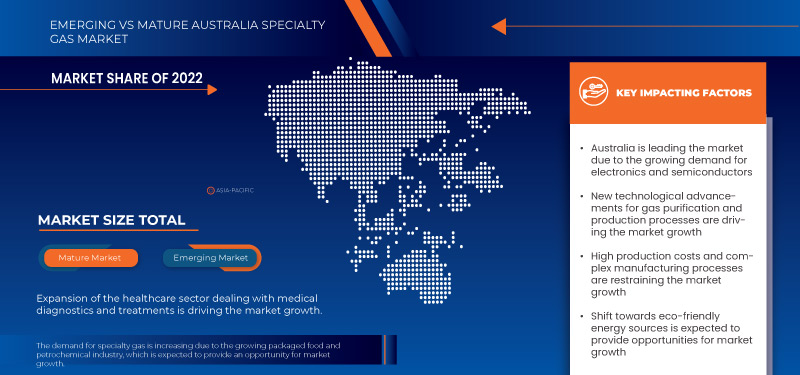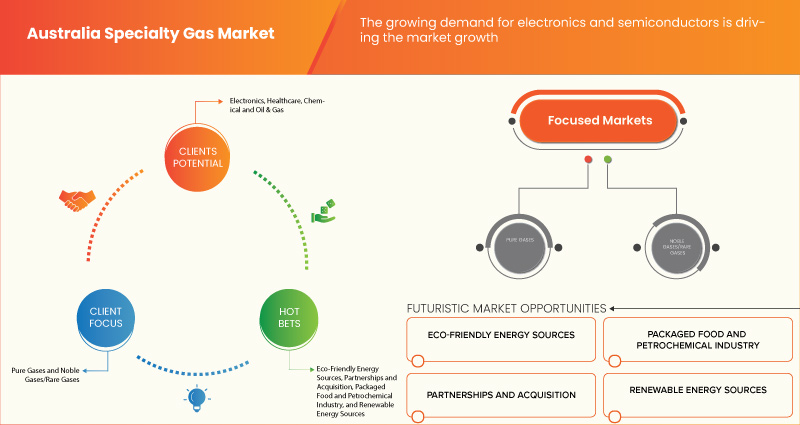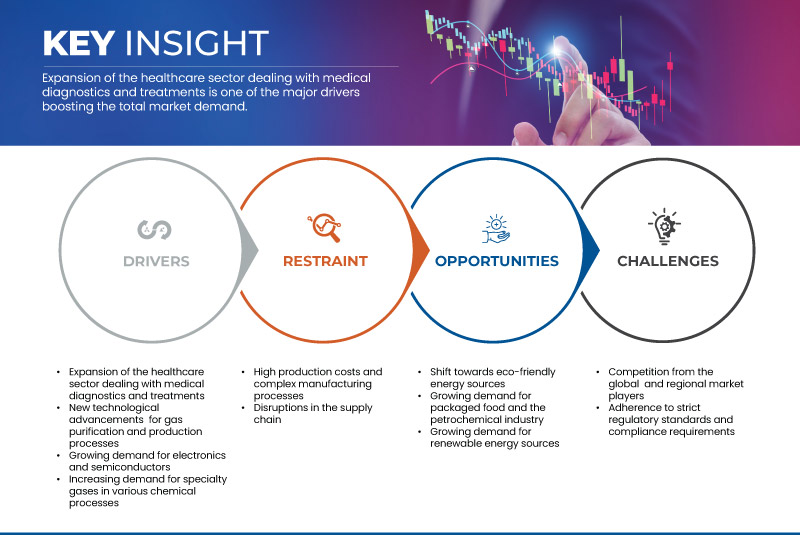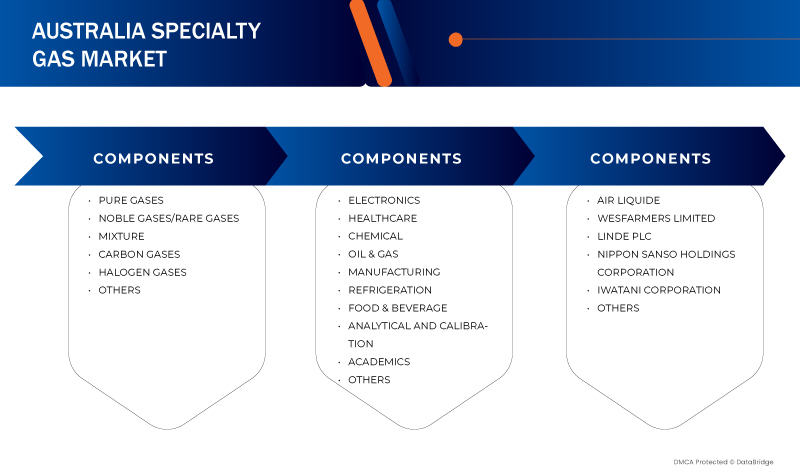Australia Specialty Gas Market
Tamaño del mercado en miles de millones de dólares
Tasa de crecimiento anual compuesta (CAGR) :
% 
| 2024 –2031 | |
| USD 1,507.77 Billion | |
| USD 2,091.80 Billion | |
|
|
|
Australia Specialty Gas Market, By Type (Pure Gases, Noble Gases/Rare Gases, Mixture, Carbon Gases, Halogen Gases, and Others), Application (Electronics, Healthcare, Chemical, Oil & Gas, Manufacturing, Refrigeration, Food & Beverage, Analytical and Calibration, Academics, and Others) - Industry Trends and Forecast to 2031.
Australia Specialty Gas Market Analysis and Size
The specialty gas industry is expected to increase steadily going forward, consistent with the close relationship between its growth and the developments in the Australian healthcare system. Specialty gases are essential parts of the healthcare ecosystem because of the ongoing emphasis on patient-centric and precision medicine and the continued prioritization of healthcare advances. Essentially, the trajectory of the market is closely linked to the endeavor to achieve healthcare excellence, rendering it a crucial facilitator of advancement within the more expansive framework of medical diagnosis and therapies.
For instance,
helium is essential for medical care. It helps MRI devices provide high-resolution images when it is in liquid form. It works well as a tracer gas in laboratory settings to find leaks. The dependability of helium is guaranteed by OSC's dedication to quality, highlighting its leadership in supplying necessary gases to enhance medical diagnostics and preserve equipment integrity.
Data Bridge Market Research analyzes that the Australia specialty gas market is expected to reach USD 2,091.80 million by 2031 from USD 1,507.77 million in 2023, growing at a CAGR of 4.2% during the forecast period of 2024 to 2031.
|
Report Metric |
Details |
|
Forecast Period |
2024 to 2031 |
|
Base Year |
2023 |
|
Historic Years |
2022 (Customizable to 2016- 2021) |
|
Quantitative Units |
Revenue in USD Million |
|
Segments Covered |
Type (Pure Gases, Noble Gases/Rare Gases, Mixture, Carbon Gases, Halogen Gases, and Others), Application (Electronics, Healthcare, Chemical, Oil & Gas, Manufacturing, Refrigeration, Food & Beverage, Analytical and Calibration, Academics, and Others) |
|
Countries Covered |
Australia |
|
Market Players Covered |
CAC Gas & Instrumentation, Scientific Gas Australia Pty Ltd, Linde plc, Air Liquide, NIPPON SANSO HOLDINGS CORPORATION, WESFARMERS LIMITED, Iwatani Corporation, BASF SE, Supagas, and OSGas among others |
Australia Specialty Gas Market Definition
Specialty gases, crucial in precision industries, refer to meticulously produced gases with specific compositions meeting stringent purity and accuracy requirements. These gases include calibration, zero, carrier, span, instrumentation, and bump test gases. Ranging from pure gases to intricate mixtures, they feature concentrations from the percent range down to part per billion or even part per trillion. They are used in analytical procedures such as chromatography and infrared spectroscopy, and their purity requires specific equipment such as regulators.
Australia Specialty Gas Market Dynamics
Drivers
- New Technological Advancements for Gas Purification and Production Processes
Modern inventions that improve the quality of specialty gases while simultaneously promoting environmental preservation are causing a revolutionary change in the industry. The use of cutting-edge membrane separation technologies is one major factor propelling the market growth. These technologies provide an environmentally benign and more energy-efficient substitute for conventional gas separation techniques. High-performance polymeric membranes can be incorporated to enable exact gas molecule separation to ensure the production of ultra-pure specialized gases. This reduces energy consumption and the overall environmental impact of producing gas, in addition to meeting stringent industry criteria.
- Growing Demand for Electronics and Semiconductors
The rising technical landscape, where advancements in electronic devices and semiconductor production are becoming increasingly vital to numerous businesses, can be linked to this rapid rise. The thriving electronics sector is a primary driver of Australia's expanding demand for specialty gases. The demand for specialty gases used in the production processes of consumer electronics, communication devices, and smart technologies increases as they evolve. For instance, the manufacture of modern microelectronics such as integrated circuits and microprocessors necessitates a precise and controlled environment that can only be achieved by using specialty gases. This comprises gases such as high-purity nitrogen, argon, and a variety of dopant gases used in semiconductor production. The specialty gas market is anticipated to expand gradually as these industries continue to shift, providing providers with a unique opportunity to fulfill the specific needs of this developing market. Thus, the rising demand for semiconductors and electronics is fuelling the market growth.
Opportunities
- Shift Towards Eco-Friendly Energy Sources
Specialty gases are vital to many industries, enabling cleaner energy solutions and technological improvements. The country understands the significance of cutting its carbon footprint and adopting sustainable policies. The renewable energy industry increases the need for specialty gases. Australia is a leader in the development and use of wind turbines and solar panels due to its commitment to increasing the proportion of renewable energy in its power generation mix. Specific gases are vital to various green energy technologies. Examples include high-purity gases used in photovoltaic cell manufacture and specialty mixes used in wind turbine maintenance. The Australian government's continued emphasis on environmental preservation means that the specialty gas industry will be essential to supporting the country's green ambitions. Thus, the transition to more environmentally friendly energy sources is expected to provide an opportunity for market growth and expand the business.
- Growing Packaged Food and Petrochemical Industry
Specialty gases are essential in the packaged food business because their quality and shelf life are highly valued. Modified Atmosphere Container (MAP), for instance, uses specialty gases to change the atmosphere inside the packaging, extending the shelf life of perishable items. This lessens the need for preservatives while simultaneously guaranteeing the products' freshness. Specialty gases such as carbon dioxide and nitrogen are in high demand as Australia experiences a growing trend toward packaged foods that are ready to eat.
The specialty gas market has a significant application in the packaged food and petrochemical sectors. The specialty gas sector can take advantage of this trend, driving economic growth and establishing Australia as a major participant in the specialty gas market by collaborating strategically, innovating, and putting sustainability first. Thus, the developing petrochemical and packaged food industries are expected to provide an opportunity for market growth.
Restraints/Challenges
- High Production Costs and Complex Manufacturing Processes
One of the major hurdles is the exorbitant production costs associated with specialty gas manufacturing. The raw materials required for producing high-purity specialty gases often involve intricate extraction and purification processes, driving up overall expenses. For instance, gases such as ultra-high purity nitrogen or specialty calibration gases demand stringent quality control measures and necessitate the use of advanced technologies, making production cost-intensive. This financial burden is subsequently transferred to consumers, making specialty gases less economically viable for various industries. Thus, the complex manufacturing process and high production costs are limiting market expansion and growth.
- Competition from the Global and Regional Market Players
Multinational companies entering the market with significant financial resources, cutting-edge technologies, and vast distribution networks present one significant barrier. These multinational corporations are able to provide low pricing together with a wide range of products by utilizing economies of scale. It might be difficult for local Australian companies to match these multinational companies’ price methods without losing money. Local competitors may find it challenging to match the economies of scale if a multinational firm introduces bulk purchasing arrangements or long-term relationships with customers.
Competing with both regional and international firms presents challenges for the specialty gas sector. Overcoming these obstacles calls for a blend of innovation, distinction, and strategic partnership to ensure the sustained growth and prosperity of local firms in this dynamic market scenario. Specialty gas producers must prioritize cost-effectiveness, innovation, and environmental sustainability in response to shifting industry preferences. Failure to do so will limit their market share and increase competition from both local and international players, which could seriously impede the market growth. Thus, competition from the global and regional market players is expected to act as a challenge to market growth.
Recent Development
- In March 2023, Coregas, a subsidiary of WESFARMERS LIMITED, was honored to be one of the 180 suppliers named to the 2023 awards. The company was chosen for this award because of its participation in Rio's campaign to provide much-needed medical oxygen to Indian communities affected by COVID-19 and medical oxygen shortages around the country. This helped the company in gaining customer awareness.
- In July 2021, Iwatani Corporation established Iwatani Australia Pty. Ltd. in Brisbane, Queensland, Australia with the intention of conducting local market and infrastructure research and strengthening relationships with affiliated companies and the state government to procure a large amount of hydrogen. This helped the company in developing a large-scale supply network.
Market Scope
Australia specialty gas market is segmented into two notable segments based on type and application. The growth amongst these segments will help you analyze major growth segments in the industries and provide the users with a valuable market overview and market insights to make strategic decisions to identify core market applications.
Type
- Pure Gases
- Noble Gases/Rare Gases
- Mixture
- Carbon Gases
- Halogen Gases
- Others
On the basis of type, the market is segmented into pure gases, noble gases/rare gases, mixture, carbon gases, halogen gases, and others.
Application
- Electronics
- Healthcare
- Chemical
- Oil & Gas
- Manufacturing
- Refrigeration
- Food & Beverage
- Analytical and Calibration
- Academics
- Others
On the basis of application, the market is segmented into electronics, healthcare, chemical, oil & gas, manufacturing, refrigeration, food & beverage, analytical and calibration, academics, and others.
Competitive Landscape and Australia Specialty Gas Market Share Analysis
Australia specialty gas market competitive landscape provides details of competitors. Details included are company overview, company financials, revenue generated, market potential, investment in research and development, new market initiatives, production sites and facilities, company strengths and weaknesses, product launch, product trials pipelines, product approvals, patents, product width and breadth, application dominance, and technology lifeline curve. The above data points provided are only related to the companies’ focus related to the market.
Some of the major players operating in Australia specialty gas market are CAC Gas & Instrumentation, Scientific Gas Australia Pty Ltd, Linde plc, Air Liquide, NIPPON SANSO HOLDINGS CORPORATION, WESFARMERS LIMITED, Iwatani Corporation, BASF SE, Supagas, and OSGas, among others.
SKU-
Obtenga acceso en línea al informe sobre la primera nube de inteligencia de mercado del mundo
- Panel de análisis de datos interactivo
- Panel de análisis de empresas para oportunidades con alto potencial de crecimiento
- Acceso de analista de investigación para personalización y consultas
- Análisis de la competencia con panel interactivo
- Últimas noticias, actualizaciones y análisis de tendencias
- Aproveche el poder del análisis de referencia para un seguimiento integral de la competencia
Tabla de contenido
1 INTRODUCTION
1.1 OBJECTIVES OF THE STUDY
1.2 MARKET DEFINITION
1.3 OVERVIEW OF THE AUSTRALIA SPECIALTY GAS MARKET
1.4 LIMITATIONS
1.5 MARKETS COVERED
2 MARKET SEGMENTATION
2.1 MARKETS COVERED
2.2 GEOGRAPHICAL SCOPE
2.3 YEARS CONSIDERED FOR THE STUDY
2.4 CURRENCY AND PRICING
2.5 DBMR TRIPOD DATA VALIDATION MODEL
2.6 PRIMARY INTERVIEWS WITH KEY OPINION LEADERS
2.7 DBMR MARKET POSITION GRID
2.8 SECONDARY SOURCES
2.9 ASSUMPTIONS
3 EXECUTIVE SUMMARY
4 PREMIUM INSIGHTS
4.1 MARKET APPLICATION COVERAGE GRID
4.2 PESTLE ANALYSIS
4.2.1 POLITICAL FACTORS
4.2.2 ECONOMIC FACTORS
4.2.3 SOCIAL FACTORS
4.2.4 TECHNOLOGICAL FACTORS
4.2.5 LEGAL FACTORS
4.2.6 ENVIRONMENTAL FACTORS
4.3 PORTER’S FIVE FORCES
4.3.1 THREAT OF NEW ENTRANTS
4.3.2 THREAT OF SUBSTITUTES
4.3.3 CUSTOMER BARGAINING POWER
4.3.4 SUPPLIER BARGAINING POWER
4.3.5 INTERNAL COMPETITION (RIVALRY)
4.4 VENDOR SELECTION CRITERIA
5 MARKET OVERVIEW
5.1 DRIVERS
5.1.1 EXPANSION OF THE HEALTHCARE SECTOR DEALING WITH MEDICAL DIAGNOSTICS AND TREATMENTS
5.1.2 NEW TECHNOLOGICAL ADVANCEMENTS FOR GAS PURIFICATION AND PRODUCTION PROCESSES
5.1.3 GROWING DEMAND FOR ELECTRONICS AND SEMICONDUCTORS
5.1.4 INCREASING DEMAND FOR SPECIALTY GASES IN VARIOUS CHEMICAL PROCESSES
5.2 RESTRAINTS
5.2.1 HIGH PRODUCTION COSTS AND COMPLEX MANUFACTURING PROCESSES
5.2.2 DISRUPTIONS IN THE SUPPLY CHAIN
5.3 OPPORTUNITIES
5.3.1 SHIFT TOWARDS ECO-FRIENDLY ENERGY SOURCES
5.3.2 GROWING PACKAGED FOOD AND PETROCHEMICAL INDUSTRY
5.3.3 GROWING DEMAND FOR RENEWABLE ENERGY SOURCES
5.4 CHALLENGES
5.4.1 COMPETITION FROM THE GLOBAL AND REGIONAL MARKET PLAYERS
5.4.2 ADHERENCE TO STRICT REGULATORY STANDARDS AND COMPLIANCE REQUIREMENTS
6 AUSTRALIA SPECIALTY GAS MARKET, BY TYPE
6.1 OVERVIEW
6.2 PURE GASES
6.2.1 PURE GASES, BY TYPE
6.2.1.1 NITROGEN
6.2.1.2 OXYGEN
6.2.1.3 HYDROGEN
6.2.1.4 OTHERS
6.3 NOBLE GASES/RARE GASES
6.3.1 NOBLE GASES/RARE GASES, BY TYPE
6.3.1.1 ARGON
6.3.1.2 HELIUM
6.3.1.3 NEON
6.3.1.4 KRYPTON
6.3.1.5 OTHERS
6.4 MIXTURE
6.5 CARBON GASES
6.5.1 CARBON GASES, BY TYPE
6.5.1.1 METHANE
6.5.1.2 CARBON MONOXIDE
6.5.1.3 ETHANE
6.5.1.4 OTHERS
6.6 HALOGEN GASES
6.6.1 HALOGEN GASES, BY TYPE
6.6.1.1 CHLORINE
6.6.1.2 FLUORINE
6.6.1.3 BROMINE
6.6.1.4 IODINE
6.6.1.5 OTHERS
6.6.2 OTHERS
7 AUSTRALIA SPECIALTY GAS MARKET, BY APPLICATION
7.1 OVERVIEW
7.2 ELECTRONICS
7.2.1 ELECTRONICS, BY TYPE
7.2.1.1 NOBLE GASES/RARE GASES
7.2.1.2 PURE GASES
7.2.1.3 MIXTURE
7.2.1.4 HALOGEN GASES
7.2.1.5 CARBON GASES
7.2.1.6 OTHERS
7.3 HEALTHCARE
7.3.1 HEALTHCARE, BY TYPE
7.3.1.1 PURE GASES
7.3.1.2 MIXTURE
7.3.1.3 NOBLE GASES/RARE GASES
7.3.1.4 HALOGEN GASES
7.3.1.5 CARBON GASES
7.3.1.6 OTHERS
7.4 CHEMICAL
7.4.1 CHEMICAL, BY TYPE
7.4.1.1 PURE GASES
7.4.1.2 CARBON GASES
7.4.1.3 HALOGEN GASES
7.4.1.4 MIXTURE
7.4.1.5 NOBLE GASES/RARE GASES
7.4.1.6 OTHERS
7.5 OIL & GAS
7.5.1 OIL & GAS, BY TYPE
7.5.1.1 PURE GASES
7.5.1.2 MIXTURE
7.5.1.3 CARBON GASES
7.5.1.4 NOBLE GASES/RARE GASES
7.5.1.5 HALOGEN GASES
7.5.1.6 OTHERS
7.6 MANUFACTURING
7.6.1 MANUFACTURING, BY TYPE
7.6.1.1 PURE GASES
7.6.1.2 CARBON GASES
7.6.1.3 NOBLE GASES/RARE GASES
7.6.1.4 MIXTURE
7.6.1.5 HALOGEN GASES
7.6.1.6 OTHERS
7.7 REFRIGERATION
7.7.1 REFRIGERATION, BY TYPE
7.7.1.1 HALOGEN GASES
7.7.1.2 MIXTURE
7.7.1.3 CARBON GASES
7.7.1.4 NOBLE GASES/RARE GASES
7.7.1.5 PURE GASES
7.7.1.6 OTHERS
7.8 FOOD & BEVERAGE
7.8.1 FOOD & BEVERAGE, BY TYPE
7.8.1.1 CARBON GASES
7.8.1.2 PURE GASES
7.8.1.3 MIXTURE
7.8.1.4 NOBLE GASES/RARE GASES
7.8.1.5 HALOGEN GASES
7.8.1.6 OTHERS
7.9 ANALYTICAL AND CALIBRATION
7.9.1 ANALYTICAL AND CALIBRATION, BY TYPE
7.9.1.1 MIXTURE
7.9.1.2 PURE GASES
7.9.1.3 NOBLE GASES/RARE GASES
7.9.1.4 CARBON GASES
7.9.1.5 HALOGEN GASES
7.9.1.6 OTHERS
7.1 ACADEMICS
7.10.1 ACADEMICS, BY TYPE
7.10.1.1 PURE GASES
7.10.1.2 MIXTURE
7.10.1.3 NOBLE GASES/RARE GASES
7.10.1.4 CARBON GASES
7.10.1.5 HALOGEN GASES
7.10.1.6 OTHERS
7.11 OTHERS
7.11.1 OTHERS, BY TYPE
7.11.1.1 NOBLE GASES/RARE GASES
7.11.1.2 PURE GASES
7.11.1.3 CARBON GASES
7.11.1.4 MIXTURE
7.11.1.5 HALOGEN GASES
7.11.1.6 OTHERS
8 COMPANY SHARE ANALYSIS: AUSTRALIA
8.1 AWARD
8.2 AGREEMENT
8.3 PARTNERSHIP
8.4 NEW FACILITY
9 SWOT ANALYSIS
10 COMPANY PROFILES
10.1 AIR LIQUIDE
10.1.1 COMPANY SNAPSHOT
10.1.2 REVENUE ANALYSIS
10.1.3 PRODUCT PORTFOLIO
10.1.4 RECENT DEVELOPMENT
10.2 WESFARMERS LIMITED
10.2.1 COMPANY SNAPSHOT
10.2.2 REVENUE ANALYSIS
10.2.3 PRODUCT PORTFOLIO
10.2.4 RECENT DEVELOPMENTS
10.3 LINDE PLC
10.3.1 COMPANY SNAPSHOT
10.3.2 REVENUE ANALYSIS
10.3.3 PRODUCT PORTFOLIO
10.3.4 RECENT DEVELOPMENT
10.4 NIPPON SANSO HOLDINGS CORPORATION
10.4.1 COMPANY SNAPSHOT
10.4.2 REVENUE ANALYSIS
10.4.3 PRODUCT PORTFOLIO
10.4.4 RECENT DEVELOPMENT
10.5 IWATANI CORPORATION
10.5.1 COMPANY SNAPSHOT
10.5.2 REVENUE ANALYSIS
10.5.3 PRODUCT PORTFOLIO
10.5.4 RECENT DEVELOPMENT
10.6 BASF SE
10.6.1 COMPANY SNAPSHOT
10.6.2 REVENUE ANALYSIS
10.6.3 PRODUCT PORTFOLIO
10.6.4 RECENT DEVELOPMENT
10.7 CAC GAS & INSTRUMENTATION
10.7.1 COMPANY SNAPSHOT
10.7.2 PRODUCT PORTFOLIO
10.7.3 RECENT DEVELOPMENTS
10.8 OSGAS
10.8.1 COMPANY SNAPSHOT
10.8.2 PRODUCT PORTFOLIO
10.8.3 RECENT DEVELOPMENT
10.9 SCIENTIFIC GAS AUSTRALIA PTY LTD
10.9.1 COMPANY SNAPSHOT
10.9.2 PRODUCT PORTFOLIO
10.9.3 RECENT DEVELOPMENT
10.1 SUPAGAS
10.10.1 COMPANY SNAPSHOT
10.10.2 PRODUCT PORTFOLIO
10.10.3 RECENT DEVELOPMENT
11 QUESTIONNAIRE
12 RELATED REPORTS
Lista de Tablas
TABLE 1 AUSTRALIA SPECIALTY GAS MARKET, BY TYPE, 2022-2031 (USD MILLION)
TABLE 2 AUSTRALIA PURE GASES IN SPECIALTY GAS MARKET, BY TYPE, 2022-2031 (USD MILLION)
TABLE 3 AUSTRALIA NOBLE GASES/RARE GASES IN SPECIALTY GAS MARKET, BY TYPE, 2022-2031 (USD MILLION)
TABLE 4 AUSTRALIA CARBON GASES IN SPECIALTY GAS MARKET, BY TYPE, 2022-2031 (USD MILLION)
TABLE 5 AUSTRALIA HALOGEN GASES IN SPECIALTY GAS MARKET, BY TYPE, 2022-2031 (USD MILLION)
TABLE 6 AUSTRALIA SPECIALTY GAS MARKET, BY APPLICATION, 2022-2031 (USD MILLION)
TABLE 7 AUSTRALIA ELECTRONICS IN SPECIALTY GAS MARKET, BY TYPE, 2022-2031 (USD MILLION)
TABLE 8 AUSTRALIA HEALTHCARE IN SPECIALTY GAS MARKET, BY TYPE, 2022-2031 (USD MILLION)
TABLE 9 AUSTRALIA CHEMICAL IN SPECIALTY GAS MARKET, BY TYPE, 2022-2031 (USD MILLION)
TABLE 10 AUSTRALIA OIL & GAS IN SPECIALTY GAS MARKET, BY TYPE, 2022-2031 (USD MILLION)
TABLE 11 AUSTRALIA MANUFACTURING IN SPECIALTY GAS MARKET, BY TYPE, 2022-2031 (USD MILLION)
TABLE 12 AUSTRALIA REFRIGERATION IN SPECIALTY GAS MARKET, BY TYPE, 2022-2031 (USD MILLION)
TABLE 13 AUSTRALIA FOOD & BEVERAGE IN SPECIALTY GAS MARKET, BY TYPE, 2022-2031 (USD MILLION)
TABLE 14 AUSTRALIA ANALYTICAL AND CALIBRATION IN SPECIALTY GAS MARKET, BY TYPE, 2022-2031 (USD MILLION)
TABLE 15 AUSTRALIA ANALYTICAL AND CALIBRATION IN SPECIALTY GAS MARKET, BY TYPE, 2022-2031 (USD MILLION)
TABLE 16 AUSTRALIA ANALYTICAL AND CALIBRATION IN SPECIALTY GAS MARKET, BY TYPE, 2022-2031 (USD MILLION)
Lista de figuras
FIGURE 1 AUSTRALIA SPECIALTY GAS MARKET: SEGMENTATION
FIGURE 2 AUSTRALIA SPECIALTY GAS MARKET: DATA TRIANGULATION
FIGURE 3 AUSTRALIA SPECIALTY GAS MARKET: DROC ANALYSIS
FIGURE 4 AUSTRALIA SPECIALTY GAS MARKET: COUNTRY VS REGIONAL ANALYSIS
FIGURE 5 AUSTRALIA SPECIALTY GAS MARKET: COMPANY RESEARCH ANALYSIS
FIGURE 6 AUSTRALIA SPECIALTY GAS MARKET: MULTIVARIATE MODELLING
FIGURE 7 AUSTRALIA SPECIALTY GAS MARKET: INTERVIEW DEMOGRAPHICS
FIGURE 8 AUSTRALIA SPECIALTY GAS MARKET: DBMR MARKET POSITION GRID
FIGURE 9 AUSTRALIA SPECIALTY GAS MARKET: SEGMENTATION
FIGURE 10 THE GROWING DEMAND FOR ELECTRONICS AND SEMICONDUCTORS IS DRIVING THE GROWTH OF THE AUSTRALIA SPECIALTY GAS MARKET IN THE FORECAST PERIOD OF 2024 TO 2031
FIGURE 11 THE PURE GASES SEGMENT IS EXPECTED TO ACCOUNT FOR THE LARGEST SHARE OF THE AUSTRALIA SPECIALTY GAS MARKET IN 2024 AND 2031
FIGURE 12 AUSTRALIA SPECIALTY GAS MARKET: MARKET APPLICATION COVERAGE GRID
FIGURE 13 VENDOR SELECTION CRITERIA
FIGURE 14 DRIVERS, RESTRAINTS, OPPORTUNITIES, AND CHALLENGES OF THE AUSTRALIA SPECIALTY GAS MARKET
FIGURE 15 AUSTRALIA EXPORT DATA LNG PRODUCER
FIGURE 16 AUSTRALIA SPECIALTY GAS MARKET: BY TYPE, 2023
FIGURE 17 AUSTRALIA SPECIALTY GAS MARKET: BY APPLICATION, 2023
FIGURE 18 AUSTRALIA SPECIALTY GAS MARKET: COMPANY SHARE 2023 (%)

Metodología de investigación
La recopilación de datos y el análisis del año base se realizan utilizando módulos de recopilación de datos con muestras de gran tamaño. La etapa incluye la obtención de información de mercado o datos relacionados a través de varias fuentes y estrategias. Incluye el examen y la planificación de todos los datos adquiridos del pasado con antelación. Asimismo, abarca el examen de las inconsistencias de información observadas en diferentes fuentes de información. Los datos de mercado se analizan y estiman utilizando modelos estadísticos y coherentes de mercado. Además, el análisis de la participación de mercado y el análisis de tendencias clave son los principales factores de éxito en el informe de mercado. Para obtener más información, solicite una llamada de un analista o envíe su consulta.
La metodología de investigación clave utilizada por el equipo de investigación de DBMR es la triangulación de datos, que implica la extracción de datos, el análisis del impacto de las variables de datos en el mercado y la validación primaria (experto en la industria). Los modelos de datos incluyen cuadrícula de posicionamiento de proveedores, análisis de línea de tiempo de mercado, descripción general y guía del mercado, cuadrícula de posicionamiento de la empresa, análisis de patentes, análisis de precios, análisis de participación de mercado de la empresa, estándares de medición, análisis global versus regional y de participación de proveedores. Para obtener más información sobre la metodología de investigación, envíe una consulta para hablar con nuestros expertos de la industria.
Personalización disponible
Data Bridge Market Research es líder en investigación formativa avanzada. Nos enorgullecemos de brindar servicios a nuestros clientes existentes y nuevos con datos y análisis que coinciden y se adaptan a sus objetivos. El informe se puede personalizar para incluir análisis de tendencias de precios de marcas objetivo, comprensión del mercado de países adicionales (solicite la lista de países), datos de resultados de ensayos clínicos, revisión de literatura, análisis de mercado renovado y base de productos. El análisis de mercado de competidores objetivo se puede analizar desde análisis basados en tecnología hasta estrategias de cartera de mercado. Podemos agregar tantos competidores sobre los que necesite datos en el formato y estilo de datos que esté buscando. Nuestro equipo de analistas también puede proporcionarle datos en archivos de Excel sin procesar, tablas dinámicas (libro de datos) o puede ayudarlo a crear presentaciones a partir de los conjuntos de datos disponibles en el informe.








